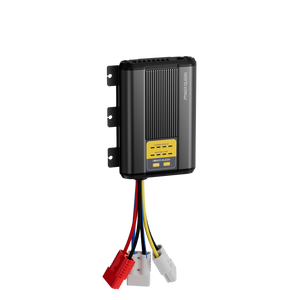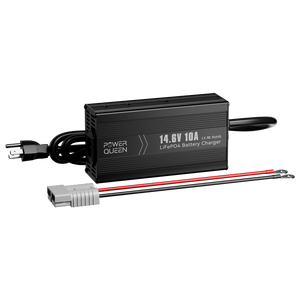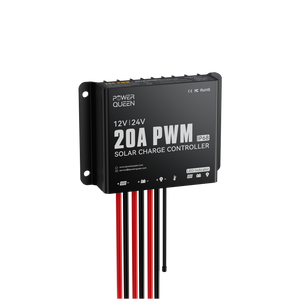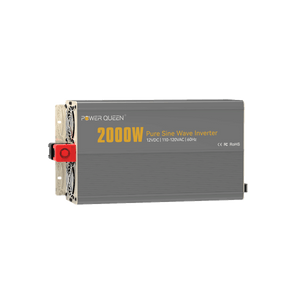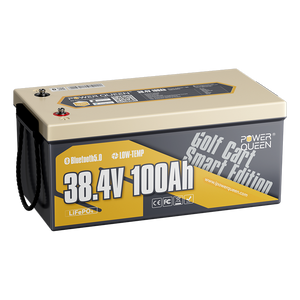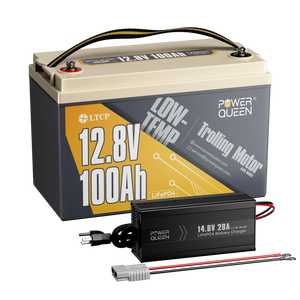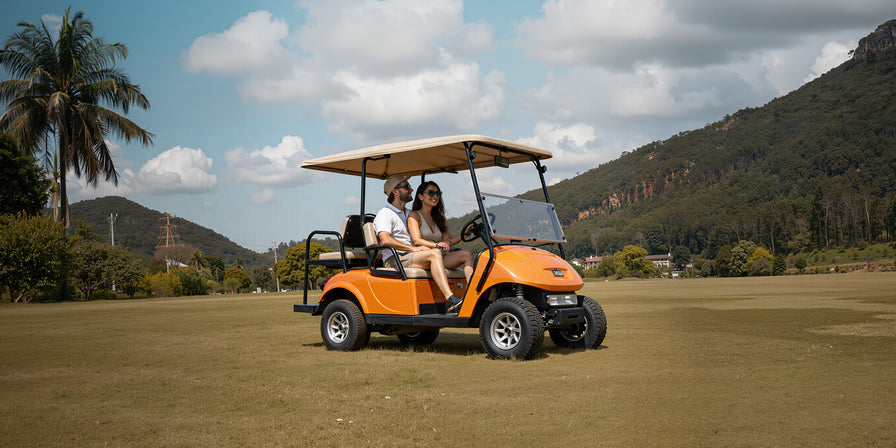[Full Guide] How to Charge LiFePO4 Batteries
Lithium Iron Phosphate (LiFePO4) batteries are becoming increasingly popular for their superior performance and longer lifespan compared to traditional lead-acid batteries. However, proper charging techniques are crucial to ensure optimal battery performance and extend the battery lifespan.
In this article, we will explore the best practices for charging LiFePO4 batteries and answer commonly asked questions.

Table of Content
- Part 1. Understanding Battery Specifications
- 1.1 Voltage and Capacity Requirements
- 1.2 Charging Rate Recommendations
- 1.3 Charge Termination Voltage
- Part 2. Main Charging Methods--CC/CV
- 2.1 (CC) Constant Current Charging
- 2.2 (CV) Constant Voltage Charging
- 2.3 Bonus Tip: Benefits to have BMS Protection’s Battery
- Part 3. Chargers of LiFePO4 Battery
- 3.1 Charge LiFePO4 Battery with Lead-Acid Battery Charger
- 3.2 Charge LiFePO4 Battery with Lithium Iron Phosphate Battery Charger
- 3.3 Charge LiFePO4 Battery with Solar Panels
- 3.4 Charge LiFePO4 Battery with Generator/Alternator
- Part 4. How To Charge Your LiFePO4 Batteries in Parallel & in Series
- Part 5. Best Practices for Charging LiFePO4 Batteries
- Part 6. How to Charge A Dead Lithium Battery
- 6.1 Using the Charger with 0V Charging Fucntion
- 6.2 Connect a controller that supports your LiFePO4 battery voltage charging to charge the battery for 3~10s in sunny daytime
- Part 7. FAQs about Charging LiFePO4 Batteries
- 7.1 Can you charge a LiFePO4 battery with a trickle charger?
- 7.2 Can a car alternator charge a LiFePO4 battery?
- 7.3 How to charge LiFePO4 battery in the cold?
- Part 8. Conclusion
Part 1. Understanding Battery Specifications
1.1 Voltage and Capacity Requirements
LiFePO4 batteries have specific voltage and capacity requirements that must be followed during charging. The recommended charge termination voltage for LiFePO4 batteries is around 3.6-3.65 volts per cell. Therefore, when charging a 12V LiFePO4 battery pack, it needs a charge termination voltage of between 14.2-14.6 volts.

Therefore, if you use a lead-acid battery charger to charge your 12V LiFePO4 battery, it's likely not to be fully charged since the voltage of 12V lead-acid battery charger is only 12.6-12.7V
1.2 Charging Rate Recommendations
It's important to follow the manufacturer's recommended charging rate when charging LiFePO4 batteries. Charging at a higher rate than the recommended maximum can damage the battery, shorten its lifespan, and reduce its capacity. The charging rate for LiFePO4 batteries usually ranges from 0.2C to 1C, with the C-rate being the battery's capacity in Ah divided by the charging current in amps.
1.3 Charge Termination Voltage
Overcharging LiFePO4 batteries can cause permanent damage, so it's essential to follow the recommended charge termination voltage. The charge termination voltage is the voltage at which the charger stops charging the battery. The charge termination voltage for LiFePO4 batteries is approximately 3.6-3.65 volts per cell. Exceeding this voltage can cause the battery to release oxygen and hydrogen gas, leading to thermal runaway and fire hazards.
To ensure safe and optimal charging, it's best to use a charger specifically designed for LiFePO4 batteries. These chargers can regulate charging current and voltage accurately and often have built-in safety features, such as overcharge protection. By following these requirements, you can maximize the performance and lifespan of your LiFePO4 batteries while minimizing the risk of damage or safety hazards.
Part 2. Main Charging Methods--CC/CV
Lithium chargers utilize a charge algorithm known as CV/CC (constant voltage/constant current). This algorithm ensures that the charger limits the current to a specific level until the battery reaches a predetermined voltage. As the battery becomes fully charged, the current gradually decreases. With this charging system, the risk of overcharging is minimized, allowing for rapid charging. Moreover, this method is compatible with various battery types, including Li-ion batteries.
2.1 (CC) Constant Current Charging
Let's say you have a 12V LiFePO4 battery with a capacity of 100Ah. The recommended maximum charging rate is 1C, which means that the charger should provide a constant current of 100 amps until the battery reaches a specific voltage level. During constant current charging, the charger will supply a higher charging rate to the battery until it reaches around 14.4-14.6 volts, which is the recommended charge termination voltage for this battery.
2.2 (CV) Constant Voltage Charging
Once the battery has reached a specified voltage level during constant current charging, the charger switches to constant voltage charging. For example, if the battery has reached 14.4 volts during constant current charging, the charger will maintain a constant voltage of 14.4 volts while gradually decreasing the charging current until it reaches the recommended charge termination voltage of around 3.6-3.65 volts per cell.
Remember that it's crucial to use an appropriate charger designed explicitly for LiFePO4 batteries and follow the manufacturer's recommended charge rates and voltage levels. Overcharging, regardless of the charging method used, can damage the battery, reduce its capacity, and shorten its lifespan.
2.3 Bonus Tip: Benefits to have BMS Protection’s Battery
The Battery Management System (BMS) serves as the brain of a battery pack, monitoring output and protecting against critical damages. The BMS achieves this by monitoring temperature, voltage, and current, forecasting or preventing failures, and collecting data through communication protocols for battery parameter analysis. The battery state of charge (SOC) indicates the percentage of energy currently stored in the battery to its nominal capacity.
Cell balancing is one of the essential key functions of BMS. By balancing cell voltages, it ensures that each cell receives an equal amount of charge, preventing the risk of imbalances in the battery pack. In turn, this promotes better performance and longevity of the battery pack.

In summary, the BMS acts as an electronic device that safeguards the battery pack against critical damages and monitors various parameters such as temperature, voltage, and current. It also collects data for analysis and ensures cell balancing, which optimizes the battery's performance and lifespan.
Batteries with BMS protection offer better safety and lifespan.
Part 3. Chargers of LiFePO4 Battery
3.1 Charge LiFePO4 Battery with Lead-Acid Battery Charger
Most lead-acid battery chargers are compatible with LiFePO4 batteries, as long as they fall within the appropriate voltage guidelines. AGM and Gel algorithms typically meet the LiFePO4 voltage requirements, but flooded battery charging algorithms often have higher voltages that may cause the BMS to disconnect. If this occurs, it's best to replace the charger with one that has a LiFePO4 charge profile. Since the BMS protects the battery, using lead-acid chargers usually won't damage it.
However, note that if the BMS disconnects due to low voltage, a lead-acid battery charger may not be able to reconnect the BMS, even if the charger is compatible with LiFePO4 charging parameters. This is because when the BMS disconnects, the lithium battery's voltage will read 0V on a voltmeter, while lead-acid chargers require the battery to have a voltage reading before starting the charging process. The same goes for some low-quality lithium chargers. Therefore, It's not recommended to charge a LiFePO4 battery with the charger designed for lead-acid batteries.
Investing in a high-quality LiFePO4 charger to ensure optimal performance and longevity of the battery is a better choice.

3.2 Charge LiFePO4 Battery with Lithium Iron Phosphate Battery Charger
Utilizing a Lithium Iron Phosphate (LiFePO4) Battery Charger is considered the most optimal method for charging LiFePO4 batteries for several reasons.
Firstly, these chargers are designed to provide precise voltage and current control during the charging process, which helps to prevent overcharging, a critical issue that can result in damage, reduced capacity, and decreased lifespan of the battery.
Secondly, LiFePO4 battery chargers are programmed to terminate the charging cycle at the recommended charge termination voltage level, around 3.6-3.65 volts per cell. By doing so, the charger reduces the risk of overcharging and extends the battery's lifespan.
Thirdly, LiFePO4 battery chargers are equipped with cell-balancing technology to ensure uniform charging across all cells, reducing imbalances that can negatively impact performance and longevity.
Fourthly, these chargers often include temperature sensors to monitor the battery's temperature during the charging process, allowing adjustments to ensure safe charging and prevent overheating, which can damage the battery.
Finally, LiFePO4 battery chargers are compatible with Battery Management Systems (BMS), ensuring that the battery remains protected throughout the charging process.

In summary, using a LiFePO4 Battery Charger provides an efficient and safe way to charge LiFePO4 batteries, with precise voltage and current control, automatic charge termination, balancing technology, temperature monitoring, and compatibility with BMS systems. These features help maintain the battery's performance and extend its overall lifespan, making such chargers highly recommended for LiFePO4 battery charging.
👉Lithium Iron Phosphate Battery Charger Recommend
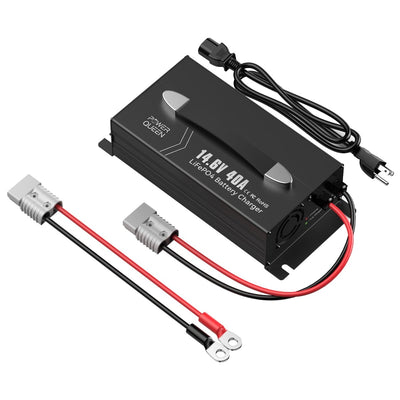
3.3 Charge LiFePO4 Battery with Solar Panels
Charging LiFePO4 batteries with solar energy is becoming increasingly popular due to its environmental and economic benefits. Here's an overview of how to charge a LiFePO4 battery with solar panels:
1. Choose a compatible solar panel: The first step is to select a solar panel that is compatible with the LiFePO4 battery's voltage and capacity requirements. Check the manufacturer's specifications to ensure that the solar panel provides the necessary voltage and amperage to charge the battery.
2.Connect the charge controller to the LiFePO4 battery: After connecting the solar panel to the charge controller, connect the charge controller to the LiFePO4 battery. Ensure that the connections are secure and follow the manufacturer's instructions carefully.
3. Connect the solar panel to a charge controller: To regulate the charging process, you need to connect the solar panel to a charge controller. The charge controller will prevent overcharging and control the charging rate to ensure safe and efficient charging.
Here we recommend you Power Queen 12/24V 30 Amp MPPT Solar Charge Controller & Bluetooth Adapter
4. Monitor the charging process: During the charging process, monitor the battery's voltage, charge rate, and temperature regularly. If the temperature rises above the recommended level, reduce the charge rate or pause the charging process to avoid overheating.
5. Disconnect the solar panel: Once the battery is fully charged, disconnect the solar panel from the charge controller to prevent overcharging, which can damage the battery.

It's essential to use high-quality components designed for LiFePO4 battery charging, including the solar panel, charge controller, and cables. Using mismatched or low-quality equipment could result in poor performance or damage to the battery, the solar panel, or the charge controller.
Overall, charging a LiFePO4 battery with solar panels can be a great way to harness renewable energy and reduce your carbon footprint. You can also find detachable types such as Power Queen portable solar panels, which have a foldable design and portable carrying case. They do not require installation and are easy to set up.
3.4 Charge LiFePO4 Battery with Generator/Alternator
When you find yourself in situations where access to electricity is limited, such as during outdoor activities or in remote locations, generators can serve as an excellent solution for charging LiFePO4 batteries.
However, it is crucial to ensure compatibility between the charging voltage and current of the generator or alternator and the specifications of your LiFePO4 battery. If the alternator or generator supports DC output, it becomes necessary to incorporate a DC-to-DC charger between the battery and the generator.

This setup guarantees that the LiFePO4 battery receives the appropriate charging conditions, minimizing the risk of any potential damage.
At Power Queen, our LiFePO4 batteries are designed to be compatible with charging from alternators or generators, providing you with a flexible charging option that can be adapted to various power sources.
Part 4. How To Charge Your LiFePO4 Batteries in Parallel & in Series
Charging LiFePO4 batteries in parallel or series requires specific considerations to ensure safe and efficient charging. Here's an overview of how to charge your LiFePO4 batteries in parallel and series:
4.1 Charging LiFePO4 Batteries in Parallel:
Connect all battery positive terminals together, followed by the negative terminals to form a single battery pack.

Use a charge controller designed for lithium batteries to connect the battery pack to the charger. The charge controller will regulate the charging process, preventing overcharging and balancing the voltage across each battery.
Monitor the charging process to ensure that the charge controller is maintaining a stable charging rate for all the batteries in the pack.
Disconnect the batteries from the charger once they are fully charged.
For optimal performance and longevity of your lithium batteries when connecting them in parallel, it is recommended to charge each battery individually before making the parallel connection(s). After charging, use a voltmeter to check the voltage of each battery a few hours later and ensure they are within 50mV (0.05V) of each other before paralleling. This procedure helps minimize the chance of any imbalance between the batteries, enhancing system performance.
Over time, it's possible to experience a decrease in your battery bank's capacity. If this occurs, it's advised to disconnect the parallel connections and charge each battery individually before reconnecting. This action will help to balance the battery voltages and restore the battery bank's capacity.
4.2 Charging LiFePO4 Batteries in Series:
Connecting lithium batteries in series is similar to connecting them in parallel. It's advisable to charge each battery up individually and check the voltage to ensure they are within 50mV (0.05V) of each other before making the series connections. This procedure helps minimize any imbalances between the batteries, promoting optimal performance.

The steps are following:
1. Connect the positive terminal of one battery to the negative terminal of another battery until you have connected all the batteries in series, creating a higher voltage battery pack.
2. Use a charge controller designed for lithium batteries with a rating suitable for the total voltage of the battery pack to connect the battery pack to the charger.
3. Monitor the charging process to ensure that the charge controller is maintaining a stable charging rate for the entire battery pack.
4. Disconnect the battery pack from the charger once they are fully charged.
Note: When charging LiFePO4 batteries in series, it's crucial to balance the voltages across each battery during the charging process to prevent imbalances that could lead to reduced performance and shorter lifespan. Ensure that the charge controller comes with cell-balancing capabilities or use a separate cell-balancer to ensure that each battery receives an equal amount of charge.
Part 5. Best Practices for Charging LiFePO4 Batteries
To ensure optimal performance and longevity of LiFePO4 batteries, it's essential to follow specific best practices when charging them. These best practices include avoiding overcharging, monitoring the charging progress, and storing the batteries at a partial state-of-charge.
Firstly, it's crucial to avoid overcharging LiFePO4 batteries, which can lead to damage, reduced capacity, and shortened lifespan. To prevent this, always use a charger designed for LiFePO4 batteries with an automatic shut-off feature once the battery is fully charged.
Secondly, monitor the charging progress regularly to ensure that the battery is receiving the right amount of voltage and current during the charging process. This helps to maintain the battery's safety and performance. Check the voltage and temperature of the battery throughout the charging process and reduce the charge rate or pause the charging process if the temperature rises above the recommended level.
Finally, storing LiFePO4 batteries at a partial state-of-charge helps to prolong their lifespan. It's advisable to store them at around 50% capacity in a cool and dry location. When storing the batteries for more than a few weeks, recharge them every few months to prevent deep discharge or over-discharge.
By following these best practices for charging LiFePO4 batteries, you can maximize their performance and extend their overall lifespan.
Part 6. How to Charge A Dead Lithium Battery
A battery that has lost all of its charge can be referred to as a dead battery. Inactivity for prolonged periods can cause a lithium battery to enter a dormant state due to self-discharge, resulting in power depletion. Here are two approaches to revive a dead lithium battery.
6.1 Using the Charger with 0V Charging Fucntion
One method to recover a dead lithium battery is by using a charger with a 0V charging function like Power Queen's LiFePO4 battery charger.

This type of charger bypasses the safety circuit built into the battery and charges it directly. By supplying a very low current, the charger can gradually increase the voltage of the battery until it reaches a safe level for normal charging. However, it's important to note that this method should be used with caution as it can be risky and may void the battery's warranty.
6.2 Connect a controller that supports your LiFePO4 battery voltage charging to charge the battery for 3~10s in sunny daytime
If you have a controller that supports LiFePO4 battery voltage charging, you can connect it to the dead battery. This method suggests charging the battery for a short duration of 3 to 10 seconds during sunny daytime to initiate the revival process. However, it's critical to ensure that the controller is compatible and set to the correct charging parameters for the LiFePO4 battery.

Part 7. FAQs about Charging LiFePO4 Batteries
7.1 Can you charge a LiFePO4 battery with a trickle charger?
LiFePO4 batteries require specific charging requirements to ensure optimal performance and safety. While it's possible to use a trickle charger to charge LiFePO4 batteries, it's not recommended.
Trickle chargers like lead acid battery chargers are designed to provide a low and continuous charge to maintain the battery capacity over time. However, LiFePO4 batteries require a higher charge rate to reach their full capacity. Charging them at a low rate can cause undercharging, which leads to reduced performance and lifespan.
Additionally, LiFePO4 batteries are sensitive to overcharging, which can lead to safety issues such as overheating, swelling, or even explosions. Some trickle chargers may not have the necessary safety features to prevent overcharging.
Therefore, it's always better to follow the manufacturer's recommendations for the charging rate and use a dedicated charger with safety features designed specifically for LiFePO4 batteries. This will help ensure that the battery is charged safely and efficiently, maximizing its overall lifespan and performance.
7.2 Can a car alternator charge a LiFePO4 battery?
Yes, a car alternator can charge a LiFePO4 (Lithium Iron Phosphate) battery. However, it's important to note that the charging process for lithium batteries differs from that of traditional lead acid batteries.
LiFePO4 batteries have specific charging requirements and voltage limits compared to lead acid batteries. While a car alternator can provide the necessary charging current, the voltage needs to be regulated to avoid overcharging the lithium battery. Overcharging can lead to damage or even cause safety issues with lithium batteries.
To safely charge a LiFePO4 battery using a car alternator, a suitable voltage regulator or charge controller specifically designed for lithium batteries should be used. This device will ensure that the charging process stays within the recommended voltage range to protect the lithium battery and maximize its lifespan.
7.3 How to charge LiFePO4 battery in the cold?
Charging LiFePO4 batteries in cold temperatures can be challenging as the charging efficiency and capacity of the battery decrease in low temperatures. Therefore, battery with low-temperature protection is important.

However, here are a few tips to help you charge your LiFePO4 battery in cold weather:
1. Keep the Battery Warm: LiFePO4 batteries perform best at temperatures above 15°C (59°F). Therefore, it's essential to keep the battery warm during the charging process. You can use an insulated bag or container to keep the battery warm while charging.
2. Use a Charger with Temperature Compensation: A charger with temperature compensation adjusts the charging voltage and current based on the battery's temperature, ensuring safe and efficient charging. Make sure to use a charger specifically designed for LiFePO4 batteries that includes this feature.
3. Charge at a Lower Rate: Charging LiFePO4 batteries at a lower rate can help prevent overheating and extend the battery's lifespan. To do so, check if your charger has a lower charge rate option or use a charger with adjustable current settings.
4. Monitor the Charging Process: It's crucial to monitor the charging process closely in cold temperatures to ensure that the battery is charging correctly without overheating. Check the temperature and voltage periodically and reduce the charging rate if the battery gets too hot.
5. Preheat the Battery: If possible, preheat the battery before charging by placing it in a warm location for some time. This helps to improve the battery's temperature and its ability to accept a charge.
By following these tips, you can help ensure that your LiFePO4 battery charges safely and efficiently in cold temperatures, optimizing its overall performance and longevity.
Lithium battery not charging? Read on to learn why and how to solve!
💡 Want a Complete Guide to Lithium Batteries in Cold Weather? For a full overview of lithium battery performance, protection mechanisms, and best practices in cold climates, read our complete guide to lithium batteries in cold weather .
Part 8. Conclusion
Proper charging is crucial for ensuring optimal performance and extending the lifespan of LiFePO4 batteries. By following the recommended charging techniques, monitoring the charging progress, and using lithium-ion-specific or adjustable chargers, you can maximize the benefits of LiFePO4 batteries. Remember to avoid overcharging, maintain a partial state-of-charge when storing the battery, and consult the manufacturer's instructions for charging recommendations. With these best practices, you can enjoy the superior performance and longevity of LiFePO4 batteries for years to come.
🎄 Christmas Savings at Power Queen🎄
From Dec 15–25, enjoy holiday pricing across all Power Queen batteries.
1 battery · 5% off | 2 batteries · 6% off | 4 batteries · 8% off




















